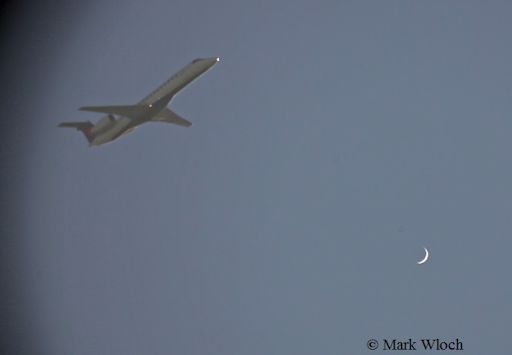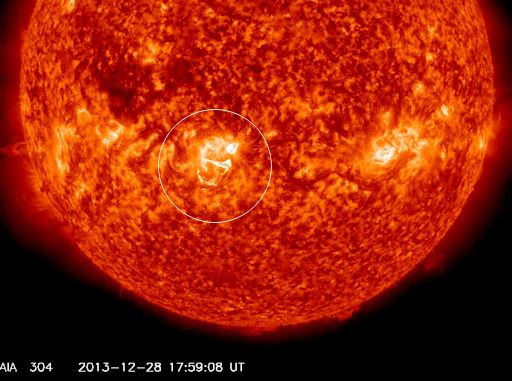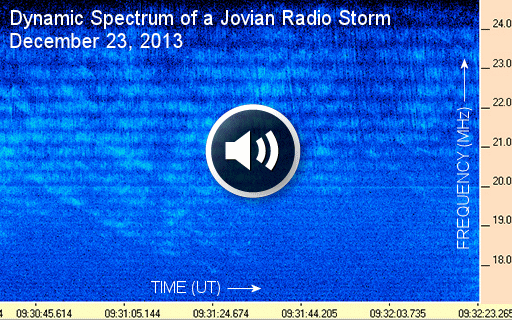MINOR RADIATION STORM IN PROGRESS: Energetic protons are swarming around Earth on Dec. 29th following a magnetic eruption near the western limb of the sun: movie. The ongoing radiation storm ranks S1 on NOAA storm scales, which means it is a relatively minor storm with little effect on spacecraft and high-altitude aviation. Solar flare alerts: text, voice.
VENUS FLYBY: Now is a great time to look at the second planet from the sun. Like the Moon, Venus has phases, and at the moment it is a 6% crescent. Moreover, it is bright enough to see in broad daylight. Yesterday, Mark Wloch pointed his Celestron C8 telescope at the blue sky over Southgate, Michigan, and this is what he saw:
"I captured Venus during daylight with a jet passing by," says Wloch. "What a beautiful conjunction."
Yes, it is easy to see Venus in broad daylight, but it is even easier to see the planet at sunset when Venus pierces the darkening sky like a beacon 150 times brighter than a 1st-magnitude star. Indeed, some sky watchers think Venus is an airplane. A quick look through a pair of binoculars, however, reveals the crescent. Point your optics southwest after sunset. No sky map is required; you can't miss Venus.
Realtime Space Weather Photo Gallery
CRACKLING SUNSPOT: AR1936 is waking up. The sunspot has a 'beta-gamma-delta' magnetic field that harbors energy for strong eruptions, yet it has been quiet for days. Now AR1936 is beginning to crackle with flares. NASA's Solar Dynamics Observatory recorded the extreme ultraviolet flash from an almost-M-class flare at 1800 UT on Dec. 28th:
Because the sunspot is facing Earth, any flares emanating from it are going to be geoeffective. So far, the extreme ultraviolet "crackles" have produced only minor waves of ionization in our planet's upper atmosphere. Earth-effects will increase, however, if the activity continues to intensify. Stay tuned! Solar flare alerts: text, voice.
Realtime Space Weather Photo Gallery
RADIO STORMS ON JUPITER: Last week, there was a storm on Jupiter--a radio storm. Amateur radio astronomer Thomas Ashcraft recorded the event on Dec. 23rd using a shortwave radio telescope located in New Mexico. Click on the image to hear the whooshing, crackling, popping sounds that emerged from his telescope's loudspeaker:
"Although few were aware of it, Earth was bathed in Jovian radio beams for an hour and half," says Ashcraft. "The audio recording captures the sounds I heard during one minute around 09:30 UT."
Jupiter's radio storms are caused by natural radio lasers in the planet's magnetosphere that sweep past Earth as Jupiter rotates. Electrical currents flowing between Jupiter's upper atmosphere and the volcanic moon Io can boost these emissions to power levels easily detected by ham radio antennas on Earth. Jovian "S-bursts" (short bursts) and "L-bursts" (long bursts) mimic the sounds of woodpeckers, whales, and waves crashing on the beach. Here are a few audio samples: S-bursts, S-bursts (slowed down 128:1), L-Bursts
Now is a good time to listen to Jupiter's radio storms. The distance between Earth and Jupiter is decreasing as the giant planet approaches opposition on Jan. 5th; and the closer Jupiter comes, the louder it gets. Jupiter is a bit like a lighthouse. It is possible to predict when the planet's most intense radio beams will sweep past Earth. The next storm is due on Dec. 30th between 10:00 and 11:00 UT. NASA's Radio Jove Project explains how to build your own receiver.

Solar wind
speed: 354.9 km/sec
density: 2.4 protons/cm3
explanation | more data
Updated: Today at 1245 UT
X-ray Solar Flares
6-hr max: M3 0756 UT Dec29
24-hr: M3 0756 UT Dec29
explanation | more data
Updated: Today at: 1200 UT
![]()
Daily Sun: 28 Dec 13
Sunspot AR1936 has a 'beta-gamma-delta' magnetic field that harbors energy for M-class solar flares. Credit: SDO/HMI
![]()
Sunspot number: 95
What is the sunspot number?
Updated 28 Dec 2013
Spotless Days
Current Stretch: 0 days
2013 total: 0 days (0%)
2012 total: 0 days (0%)
2011 total: 2 days (<1%)
2010 total: 51 days (14%)
2009 total: 260 days (71%)
Since 2004: 821 days
Typical Solar Min: 486 days
Update 28 Dec 2013
The Radio Sun
10.7 cm flux: 131 sfu
explanation | more data
Updated 28 Dec 2013
![]()
Current Auroral Oval:
Switch to: Europe, USA, New Zealand, Antarctica
Credit: NOAA/POES
![]()
Planetary K-index
Now: Kp= 2 quiet
24-hr max: Kp= 2 quiet
explanation | more data
Interplanetary Mag. Field
Btotal: 5.1 nT
Bz: 3.6 nT south
explanation | more data
Updated: Today at 1247 UT
![]()
Coronal Holes: 28 Dec 13
Solar wind flowing from the indicated coronal hole could reach Earth on Jan 2-3. Credit: SDO/AIA.







